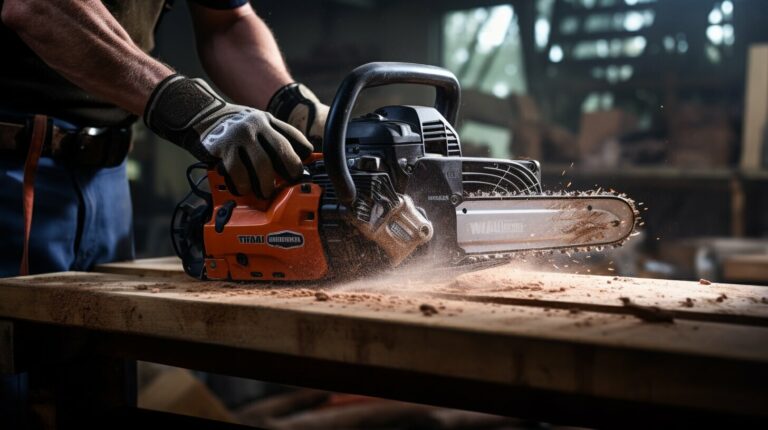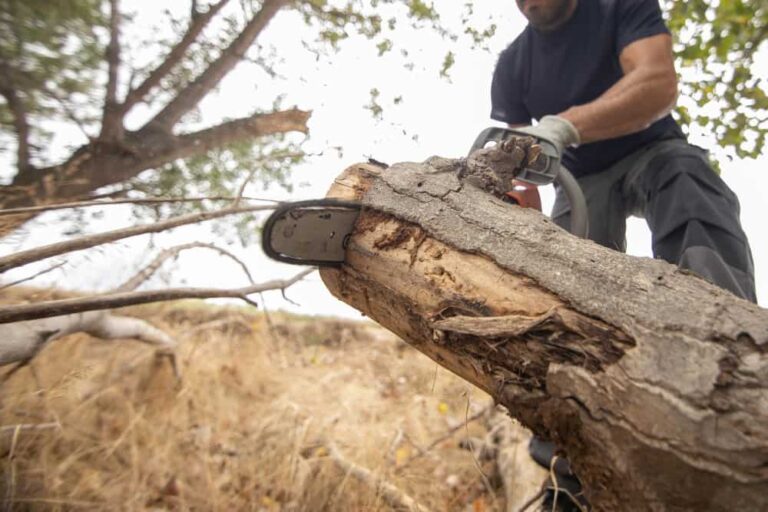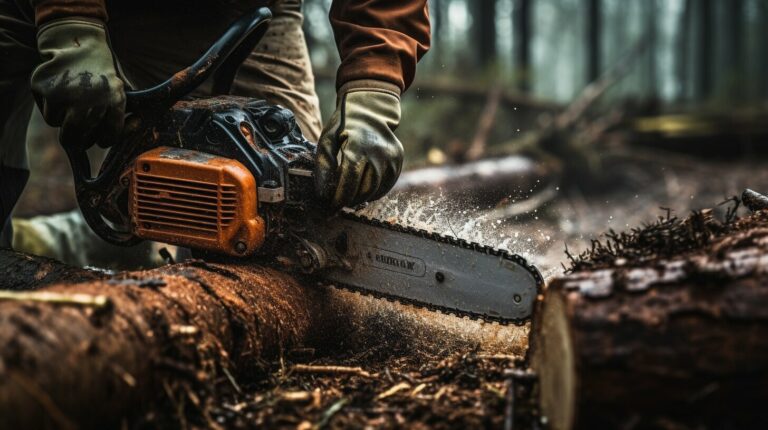Master the Tricks: How to Unflood a Chainsaw Effectively
Chainsaws are powerful tools that can make light work of even the toughest tasks. However, they are not immune to complications, such as flooding. Dealing with a flooded chainsaw can be frustrating, but fear not!
This blog post will explore some practical tips and techniques to help you overcome how to unflood a chainsaw. So, if you’ve found yourself with a flooded chainsaw and are unsure what to do, keep reading to uncover valuable insights.
how to unflood a chainsaw
Regular maintenance is key to keeping your chainsaw in top shape for all your DIY projects. You can ensure optimal chainsaw performance by addressing common issues such as spark plug defects, carburetor clogs, ignition problems, and faulty starter components. How to Unflood a Chainsaw effectively by following these step-by-step guide to unflooding your chainsaw:
Check and Replace Defective Spark Plug
A defective spark plug can cause flooding in a chainsaw. To determine if the spark plug is defective, inspect it for signs of damage or wear. Replace the spark plug with a new one to restore proper engine function.
Clean or Replace the Carburetor
A clogged carburetor can contribute to fuel flooding. Clean the carburetor thoroughly, ensuring all fuel passages are free from debris. If cleaning is not sufficient, consider replacing the carburetor for optimal performance.
Addressing Ignition Issues
If there is no spark when starting the chainsaw, it may indicate an issue with the ignition coil. Troubleshoot the ignition system to identify the problem and replace the ignition coil if necessary.
Checking and Replacing Starter Components
The recoil starter assembly plays a crucial role in starting the chainsaw. Inspect the assembly and the rewind spring for any damage or wear. Replace these components if they are faulty to ensure proper functionality.
Troubleshooting Additional Issues and Conclusion
Additional troubleshooting steps include drying and replacing the spark plug, checking the choke in warm weather conditions, and evaluating the fuel quality. If all attempts to unflood the chainsaw fail, seeking professional help or considering a replacement is advisable.
Key Takeaways:
- Regular maintenance is essential for optimal chainsaw performance.
- Check and replace a defective spark plug to prevent flooding.
- Clean or replace the carburetor to ensure proper fuel flow.
- Address ignition issues by troubleshooting and replacing the ignition coil if necessary.
- Inspect and replace faulty starter components for smooth starting.
Check and Replace Defective Spark Plug

The first step in unflooding a chainsaw is to check if the spark plug is defective. A faulty spark plug can prevent the engine from starting or cause it to flood with fuel. To inspect the spark plug, start by removing the rubber boot that covers the plug. Use a spark plug wrench to loosen and remove the plug from the cylinder.
Examine the spark plug for signs of damage or wear, such as a cracked insulator or a worn electrode. If the spark plug appears dirty or covered in oil residue, it may need to be cleaned or replaced. Cleaning can be done by using a wire brush to remove any buildup, while replacement is necessary if the plug is damaged beyond repair.
When purchasing a new spark plug, ensure it is compatible with your chainsaw model. Install the new plug by hand-tightening it into the cylinder, and then give it a final snug with the spark plug wrench. Remember not to overtighten, as this can damage the threads and cause problems in the future.
| Steps to Check and Replace Spark Plug |
|---|
| 1. Remove the rubber boot covering the spark plug. |
| 2. Use a spark plug wrench to remove the plug from the cylinder. |
| 3. Inspect the spark plug for damage or wear. |
| 4. Clean the plug with a wire brush, if necessary. |
| 5. Replace the spark plug if it is damaged or cannot be cleaned. |
| 6. Purchase a compatible spark plug for your chainsaw model. |
| 7. Hand-tighten the new plug into the cylinder, then give it a final snug with the spark plug wrench. |
Clean or Replace the Carburetor
If the chainsaw is still flooded after checking the spark plug, it’s time to clean or replace the carburetor. The carburetor is responsible for mixing fuel and air in the correct proportions for combustion. Over time, it can become clogged with fuel deposits and prevent proper fuel flow, leading to flooding. Here’s what you need to do:
- Start by disconnecting the spark plug wire to ensure the chainsaw is not accidentally started.
- Locate the carburetor, usually positioned near the engine. Take note of how the carburetor and fuel lines are connected for reassembly.
- Carefully remove the screws holding the carburetor cover using a screwdriver. Remove the cover to access the carburetor and its components.
- Inspect the carburetor for any visible signs of clogs or debris. If you notice any, use a carburetor cleaner and a soft brush to gently clean the passages and jets, ensuring they are free from obstructions.
- It may need to be replaced if the carburetor is heavily damaged or cannot be cleaned properly. Consult your chainsaw’s manual or a professional for the correct replacement carburetor.
- After cleaning or replacing the carburetor, carefully reassemble the chainsaw, ensuring all connections are secure and tight.
It’s important to note that cleaning and replacing the carburetor can be a delicate process, so it’s best to seek professional assistance if you’re unsure or uncomfortable. They will have the expertise and tools to do the job correctly. Additionally, if you’re unfamiliar with working on engines or chainsaws, it’s always recommended to consult an expert.
Regular maintenance, including cleaning or replacing the carburetor when necessary, will help keep your chainsaw running smoothly and prevent future flooding issues.
Table: Signs of a Clogged Carburetor
| Signs | Possible Cause |
|---|---|
| Chainsaw starts but stalls immediately | Fuel is not flowing properly due to carburetor clog |
| Chainsaw hesitates or lacks power during operation | Inadequate fuel mixture caused by a partially clogged carburetor |
| Excessive fuel consumption | Carburetor is not delivering the correct fuel-to-air ratio |
| Difficulty starting the chainsaw | Carburetor clog preventing proper fuel flow |
By following these steps and properly maintaining your chainsaw, you can tackle your DIY projects and easily avoid frustrating flooding issues.
Addressing Ignition Issues
If your chainsaw fails to start without a spark, it’s time to address ignition issues. The ignition coil produces the electrical spark that ignites the fuel mixture in the engine. If the ignition coil is faulty or damaged, it can prevent the spark from occurring, resulting in a chainsaw that won’t start.
To troubleshoot ignition problems, check the connections between the ignition coil and the spark plug. Ensure that the wires are securely attached and not damaged. If everything looks fine, use a multimeter to test the ignition coil for continuity. If there is no continuity, the ignition coil is defective and must be replaced.
Replacing the ignition coil is a relatively simple process. Start by disconnecting the spark plug wire and removing the old ignition coil. Install the new ignition coil and connect the spark plug wire. Make sure to follow the manufacturer’s specific instructions for your chainsaw model. Once the new ignition coil is in place, try starting the chainsaw again to see if the spark is now present.
Table: Common Symptoms of Ignition Issues
| Symptom | Possible Cause |
|---|---|
| No spark | Faulty ignition coil |
| Intermittent spark | Loose or damaged ignition coil connections |
| Weak spark | Worn-out ignition coil |
If addressing ignition issues doesn’t solve the problem, move on to the next section to check and replace other potential components that may be causing your chainsaw to flood or fail to start.
Checking and Replacing Starter Components
If your chainsaw’s starter cord doesn’t rewind or won’t start, it’s important to check and replace the recoil starter assembly. The recoil starter assembly starts the chainsaw’s engine by pulling the cord. Over time, the recoil starter assembly can wear out or become damaged, resulting in difficulty starting the chainsaw. Fortunately, replacing it is a relatively simple process that can get your chainsaw back up and running smoothly.
To begin, gather the necessary tools for the job, including a wrench, screwdriver, and replacement recoil starter assembly. Locate the recoil starter assembly on your chainsaw, which is typically positioned near the top or side of the engine. Carefully remove any screws or bolts, securing the assembly using the appropriate tools. Once the assembly is loose, detach the starter cord from it, making note of the cord’s position.
Next, install the new recoil starter assembly by aligning it with the mounting holes on the engine. Secure the assembly in place by tightening the screws or bolts. Throw the starter cord through the designated opening on the assembly, ensuring it is properly positioned and untangled. Gently pull on the cord to release any slack, then wind it around the assembly, following the correct direction indicated by arrows or markings.
Finally, test the recoil starter assembly by pulling the cord firmly. If it rewinds smoothly and offers resistance when pulled, you have successfully replaced the recoil starter assembly. Your chainsaw should now start easily and the starter cord should rewind properly after each use. Regularly maintaining and inspecting the recoil starter assembly will help ensure its longevity and prevent future starting issues.
| Steps to Check and Replace Recoil Starter Assembly |
|---|
| 1. Gather necessary tools: wrench, screwdriver, and replacement recoil starter assembly. |
| 2. Locate the recoil starter assembly on your chainsaw and remove any securing screws or bolts. |
| 3. Detach the starter cord from the old assembly, noting its position. |
| 4. Install the new recoil starter assembly, align it with the mounting holes, and secure it in place. |
| 5. Thread the starter cord through the designated opening and wind it in the correct direction indicated. |
| 6. Test the recoil starter assembly by pulling the cord firmly. It should rewind smoothly and offer resistance. |
Following these steps to check and replace the recoil starter assembly, you can address starting issues with your chainsaw and ensure it functions properly. Always consult your chainsaw’s manual for specific instructions and safety precautions before performing maintenance or repairs.
Troubleshooting Additional Issues and Conclusion

If you’ve followed the previous steps and your chainsaw still won’t start, here are some additional troubleshooting tips to consider:
- Check the fuel mixture: Ensure your chainsaw has the correct fuel-to-oil ratio. Using the wrong mixture can prevent the engine from starting. Consult your chainsaw’s manual for the recommended fuel ratio.
- Inspect the air filter: A dirty or clogged air filter can restrict airflow and prevent proper combustion. Remove the air filter and clean it or replace it if necessary.
- Examine the fuel filter: A clogged or contaminated fuel filter can restrict the fuel flow to the engine, causing starting issues. Replace the fuel filter if it appears dirty or damaged.
- Check for clogged fuel lines: Inspect the fuel lines for any blockages or kinks. Remove and clean the fuel lines or replace them if they are damaged.
- Ensure the on/off switch is in the correct position: Sometimes, a simple oversight can prevent the chainsaw from starting. Ensure the on/off switch is in the “on” position before starting the engine.
| Troubleshooting Step | Action |
|---|---|
| Check spark plug | Inspect for signs of damage or wear. Replace if necessary. |
| Clean carburetor | Remove and clean carburetor using appropriate solvents and tools. |
| Replace carburetor | If the carburetor cannot be cleaned or is severely damaged, replace it with a new one. |
| Replace ignition coil | Remove and clean the carburetor using appropriate solvents and tools. |
| The ignition coil may be faulty if there is no spark when starting the chainsaw. Install a new ignition coil if necessary. | Inspect for any damage or wear. Replace if needed. |
| Replace rewind spring | If the starter cord doesn’t rewind properly, replace the rewind spring. |
| Check the recoil starter assembly | If the engine is flooded, remove the spark plug, dry it thoroughly, and reinstall. Attempt starting again. |
| Check choke | In warm weather, ensure that the choke is not activated, as this can prevent starting. |
| Check fuel quality | If the fuel is old or deteriorated, it can impact starting. Replace with fresh fuel if necessary. |
Conclusion
How to Unflood a Chainsaw step-by-step process that involves checking and addressing various components, ensuring peak performance for your tool. Following the steps outlined in this article, you can effectively unflood your chainsaw and easily get back to your DIY projects.
To begin, start by checking if the spark plug is defective. A faulty spark plug can cause flooding, so it’s crucial to replace it if necessary. Next, clean the carburetor if it is clogged with fuel. This step is important as a clean carburetor ensures proper fuel flow and prevents flooding.
If cleaning the carburetor doesn’t resolve the issue, it may be necessary to replace it altogether. A clogged carburetor that cannot be cleaned properly can continue to cause flooding and hinder the chainsaw’s performance. Similarly, if there is no spark when starting the chainsaw, it may be a sign that the ignition coil needs replacement.
Additionally, it’s essential to check the recoil starter assembly. If faulty, it can contribute to flooding, making it necessary to replace it. Similarly, replacing the rewind spring can solve the issue if the starter cord doesn’t rewind properly.
If the engine is flooded with fuel, it’s important to dry and replace the spark plug before starting the chainsaw again. It’s also worth checking the choke, as activating it in warm weather can prevent the chainsaw from starting. Lastly, don’t forget to check the fuel quality and replace deteriorated fuel if necessary.
If, despite these efforts, your chainsaw still won’t start, it’s advisable to seek professional help or consider a replacement. Regular maintenance and addressing any issues promptly will help keep your chainsaw in top shape for all your DIY projects.
FAQ
How do I check if the spark plug is defective?
To check if the spark plug is defective, remove it from the chainsaw and inspect the electrode for wear or damage. If the electrode is fouled or the spark plug is covered in carbon buildup, it’s time to replace it.
How do I clean the carburetor?
To clean the carburetor, remove it from the chainsaw and use a carburetor cleaner to spray and clean the jets, passages, and float bowl. Make sure to follow the manufacturer’s instructions for the specific carburetor cleaner you are using.
When should I replace the carburetor?
If the carburetor cannot be properly cleaned or if it is damaged beyond repair, it is advisable to replace it with a new one. A faulty carburetor can cause fuel flooding and hinder the chainsaw’s performance.
What should I do if there is no spark?
If there is no spark when trying to start the chainsaw, it may be due to a faulty ignition coil. To address this issue, you should replace the ignition coil to ensure proper spark and ignition.
How do I check and replace the recoil starter assembly?
To check the recoil starter assembly, remove the starter cover and visually inspect the assembly for any damage or wear. If necessary, replace the recoil starter assembly and rewind spring to ensure smooth starting and cord rewinding.
What should I do if the starter cord doesn’t rewind?
If the starter cord doesn’t rewind, it may indicate a problem with the rewind spring. In this case, you should replace the rewind spring to restore proper functionality to the starter cord.
How do I dry and replace the spark plug if the engine is flooded with fuel?
If the engine is flooded with fuel, remove the spark plug and dry it thoroughly. Then, replace the spark plug with a new one and try starting the chainsaw again.
Should I activate the choke in warm weather?
No, you should not activate the choke in warm weather. The choke is used to enrich the fuel mixture during cold starts. In warm weather, it is unnecessary and can hinder the chainsaw’s performance.
When should I check and replace deteriorated fuel?
It is advisable to periodically check the fuel for deterioration. If the fuel has been sitting for a long time or has a foul smell or discoloration, it is best to replace it with fresh fuel to ensure optimal chainsaw performance.






